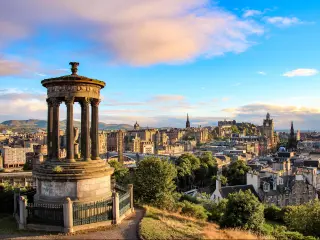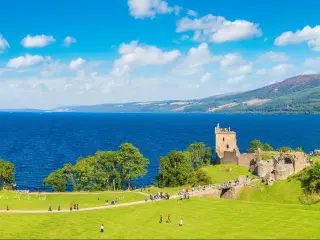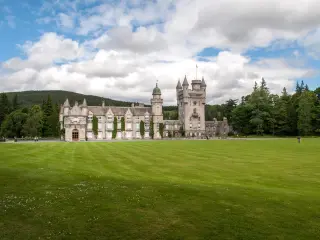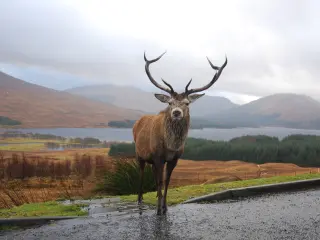Is there a Bridge to the Isle of Skye?
The Isle of Skye is the jewel in the crown of the Scottish Islands and is the largest in the archipelago that makes up the Inner Hebrides. Situated off the west coast of the Highlands, it is well known for its magnificent mountains, rugged coastline and its medieval castles, and stunning wildlife as well as the most amazing scenery.
There is a bridge to the Isle of Skye, and it leads from the mainland at Kyle of Lochalsh over the sea to Skye, arriving in Kyleakin. The journey over the impressive arched construction only takes a couple of minutes, offering incredible views of the Cuillins and beyond.
Taking the bridge to the Isle of Skye is the quickest way to reach the Island, and allows you to quickly continue your memorable trip exploring the hills and glens of this majestic and mythical Isle. Continue reading to learn more about the ways to get to Skye, how long it takes and some of the best things to do once you arrive on the Island.
Is there a bridge to the Isle of Skye?
The Isle of Skye is situated off the northwest coast of Scotland, and at the closest point is only 2 miles from the mainland. The Skye Bridge was opened in 1995, connecting the mainland town of Kyle of Lochalsh with Kyleakin on Skye.
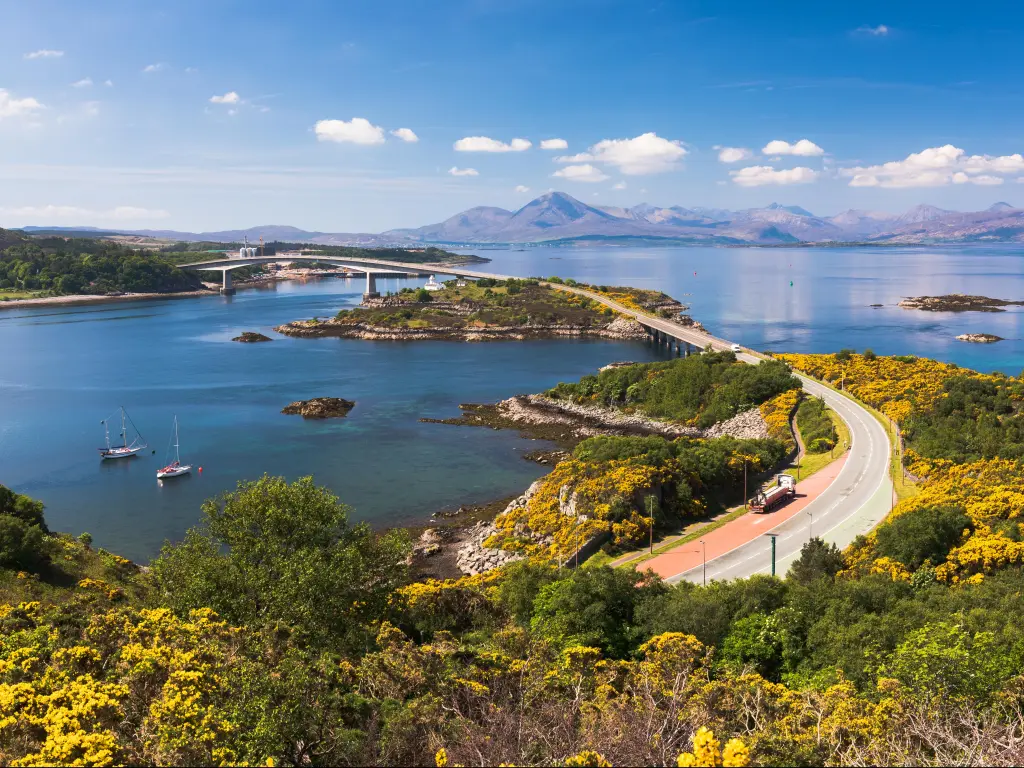
How to reach the Isle of Skye from mainland Scotland
| Route | Distance | Driving Time |
|---|---|---|
| Glasgow to Isle of Skye | 185 miles | 4 hours 5 minutes |
| Inverness to Isle of Skye | 80 miles | 1 hour 50 minutes |
| Edinburgh to Isle of Skye | 205 miles | 4 hours 20 minutes |
Most people travel to Skye by road and reach the island by taking the Skye Bridge. It is also possible to sail the short journey from the mainland by ferry. Given its location, the majority of visitors will be heading north to reach Skye and there are two main options available to reach the Kyle of Lochalsh by road. Both routes are blessed with incredible scenery, with one heading up the western side of Scotland, and the other taking a more easterly route, to begin with.
The most scenic route from Glasgow starts by taking the Erskine Bridge over the River Clyde and joining the A82, and it's not long before it heads past the stunning bonnie banks of Loch Lomond and onwards to Crianlarich, home to the infamous Green Welly Stop. The route then heads through windswept Rannoch Moor before reaching Glencoe, the sight of the famous massacre, where you are greeted with amazing mountain views in all directions.
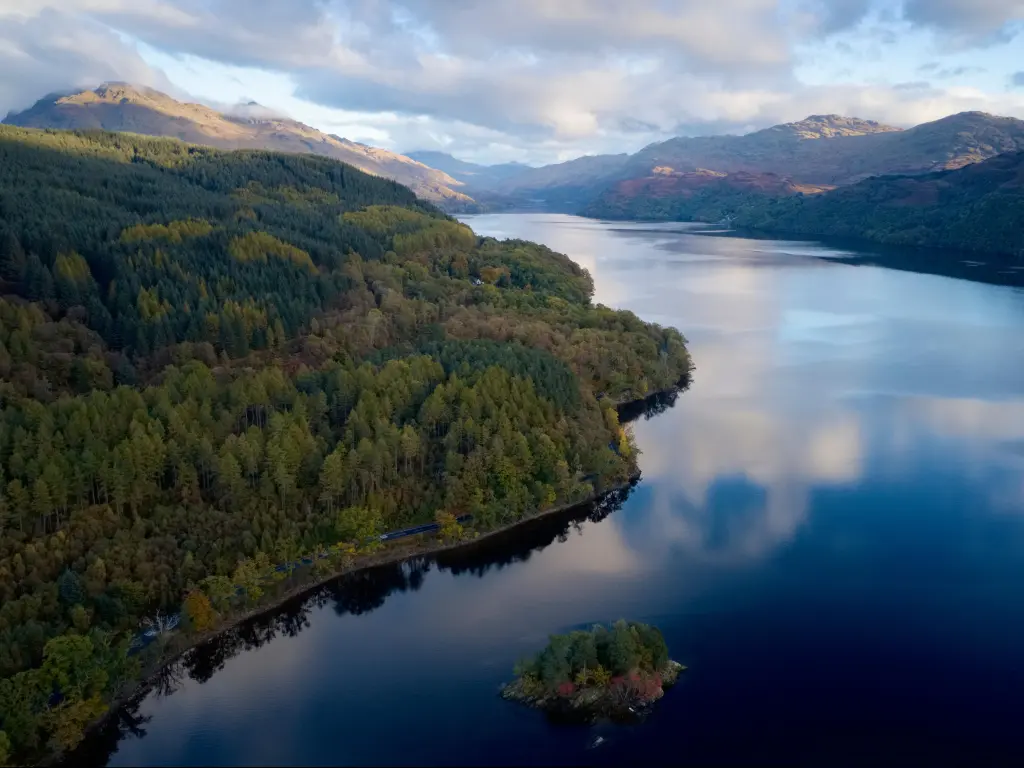
Continuing on the A82, the route reaches Fort William, with Ben Nevis looming ominously over the town, before continuing north to Invergarry. A left turn here leads onto the A87 which takes you through Glen Shiel, past Loch Duich and the ever-popular Eilean Donan Castle, before arriving at the Kyle of Lochalsh.
The other option is to head northeast from Glasgow towards Stirling and join the A9, passing Gleneagles along the way before arriving at Perth. The route then heads north towards Pitlochry as you hit the highlands, passing Blair Atholl and then the Cairngorms National Park, before passing Aviemore and arriving at Inverness. Known as the capital of the Highlands, it's an excellent place to refuel before continuing on your adventure.
Leaving Inverness, head southwest on the A82 along the northern banks of Loch Ness, keeping your eyes peeled for Nessie, before joining the A887 at Invermoriston. It's not long before the route meets the A87 and mirrors the scenic route all the way to Kyle of Lochalsh.
How to take the ferry to the Isle of Skye
The Ferry from Mallaig to Armadale is the main route for sailing to the Isle of Skye from the mainland. This popular route makes a good alternative to the bridge for visitors staying in or around Fort William, maybe to conquer the summit of Ben Nevis or enjoy the other thrilling outdoor pursuits on offer. The ferry reaches Skye at Armadale, on the Sleat Peninsula, an area known as the Garden of Skye as it is more sheltered than the more rugged landscapes further north, and is blessed with excellent walks, beaches, and whisky-tasting!
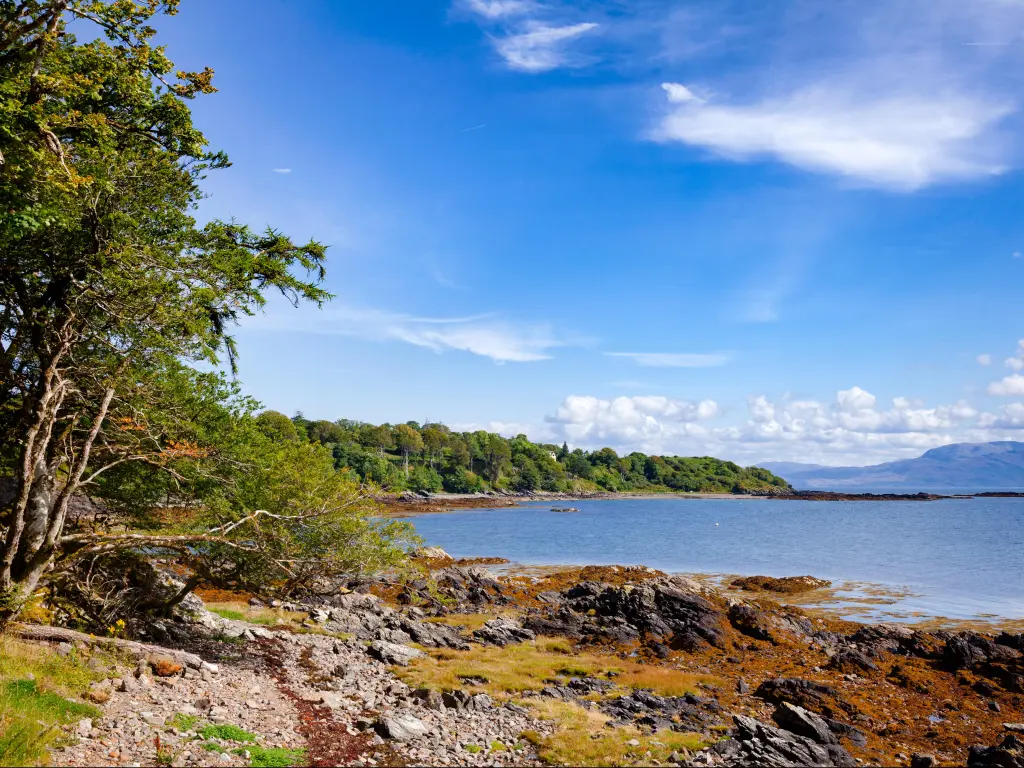
There is another ferry option that sails from the mainland to the Isle of Skye. The Ferry from Glenelg to Kylerhea is a real step back in time, as you take the original rotating deck car ferry, which only has room for 6 cars, and keeps the romance of the Skye Boat Song alive. The route to Glenelg can be challenging at times along narrow mountain roads but it's well worth it and you may be lucky enough to see whales, otters and seals as you make the crossing.
How long does it take to reach the Isle of Skye from mainland Scotland?
However you choose to reach Skye, you will enjoy the views over Loch Alsh and the Black Cuillins in the distance, and the hills of Knoydart on the mainland. Taking the bridge is the quickest way to reach the Island and it only takes 2 minutes to make the short up-and-down crossing.
Taking the ferry is also a popular option, and there are two options available. The main crossing sails from mainland Mallaig, over to Armadale in southern Skye. The service is provided by Caledonian Macbrayne, the main ferry operator in Scotland, and takes 45 minutes. The original ferry route is still in operation, running from Glenelg to Kylerhea. This much smaller ferry crosses in only 5 minutes, and only has room for 6 vehicles so you may have to wait in the queue in peak season to make the crossing this way.
How much does it cost to travel to the Isle of Skye?
There is no cost to reach the Isle of Skye via the bridge. This wasn't always the case and on its inception, there was a toll for travelling each way but this was scrapped in 2004 following continued protests from local businesses and residents.
There is also a footpath running the length of the bridge making it possible to travel to Skye on foot. This allows the chance to stop at its highest point of the arched construction and take in the incredible views over the Inner Sound and Loch Alsh. It can be extremely windy making the crossing in this way so it's vital to dress appropriately to brave the elements.
Taking the ferry from Mallaig to Armadale costs £3.20 for Adults and £1.60 for children aged 5-15 and under 5's travel free. The charge for a car or 4x4 is £10.65. These prices are for a one-way trip and can simply be doubled for a return journey.
Taking the ferry from Glenelg to Kylerhea costs £3 per person and £5 for a return trip. Making the journey by car will cost £18 and includes up to 4 passengers, with a return ticket costing £25.
Which port should you choose as your destination in the Isle of Skye?
The bridge arrives in Kyleakin and this makes a good place for your initial destination on Skye. This beautiful little village is an ideal base for exploring the Cuillin mountains and southern Skye. Many visitors head north to the capital of the island, Portree and from here, it's a perfect place for exploring the dramatic Trotternish Peninsula and the northern headland, including the Old Man of Storr and Dunvegan.
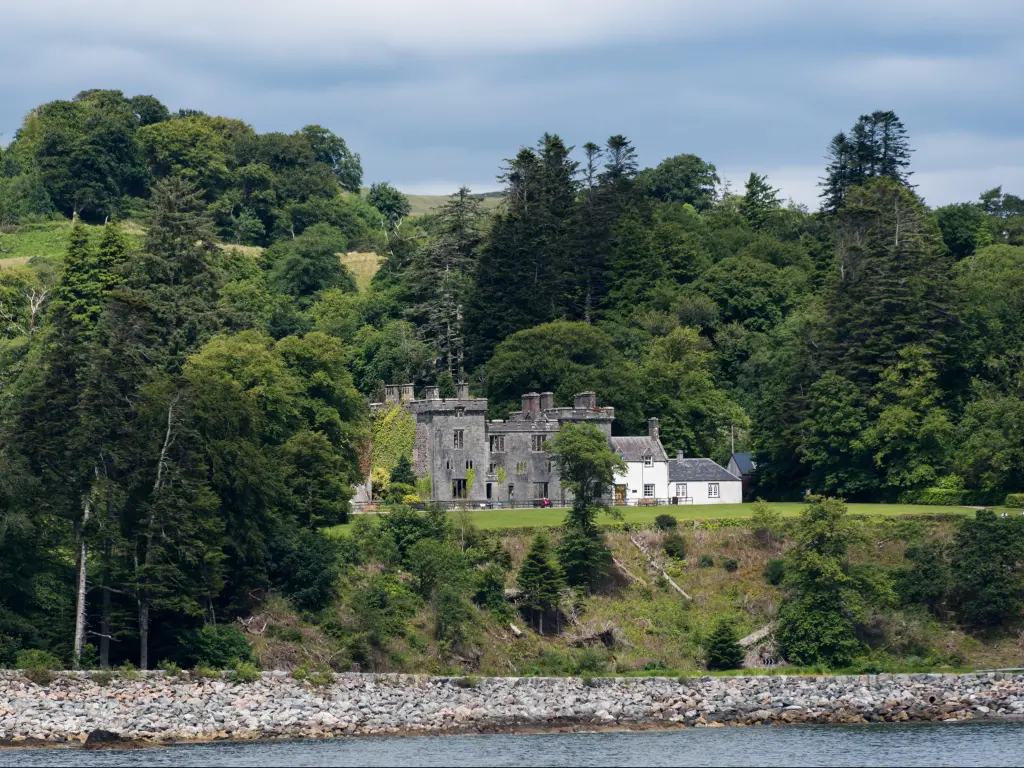
Things you need to know about travelling to the Isle of Skye
Travelling to Skye involves travelling through some of the most amazing scenery and landscapes the Scottish highlands has to offer. Here are a few tips to help make the journey even more pleasurable.
Some of the roads on the island will be single-track. Be courteous to other drivers and use the passing places to let oncoming traffic past, and pull in to let any traffic behind through.
When you reach Skye it's a good idea to refuel at Broadford, not far from the Bridge, before heading off to explore the Island. There aren't many places to fill up on the Island and you don't want to get caught out.
Skye is extremely popular with visitors flocking from all over the globe, especially in the summer months, so the traffic on the island will be busier at this time.
Best time to visit the Isle of Skye
The weather on Skye is incredibly changeable, and it's not known as the Isle of Mist for nothing! The best weather will be over the summer months, so visiting between May and September is preferable. This will give you the best chance of seeing the incredible and rugged Cuillin range in all its glory, although seeing it with a covering of snow in winter is a magnificent sight.
From late spring to September, the milder weather sees Skye's flora and fauna in bloom and at its best and the glens are bathed in a purple carpet of heather.
The island is home to nesting Sea Eagles, and they can often be seen over the Loch as you reach Skye. Neist Point in Glendale is the best place on the island for whale, dolphin, and porpoise spotting, and the best time to spot them is in June and July. There are also seal spotting trips from Broadford, not far from the Skye Bridge.
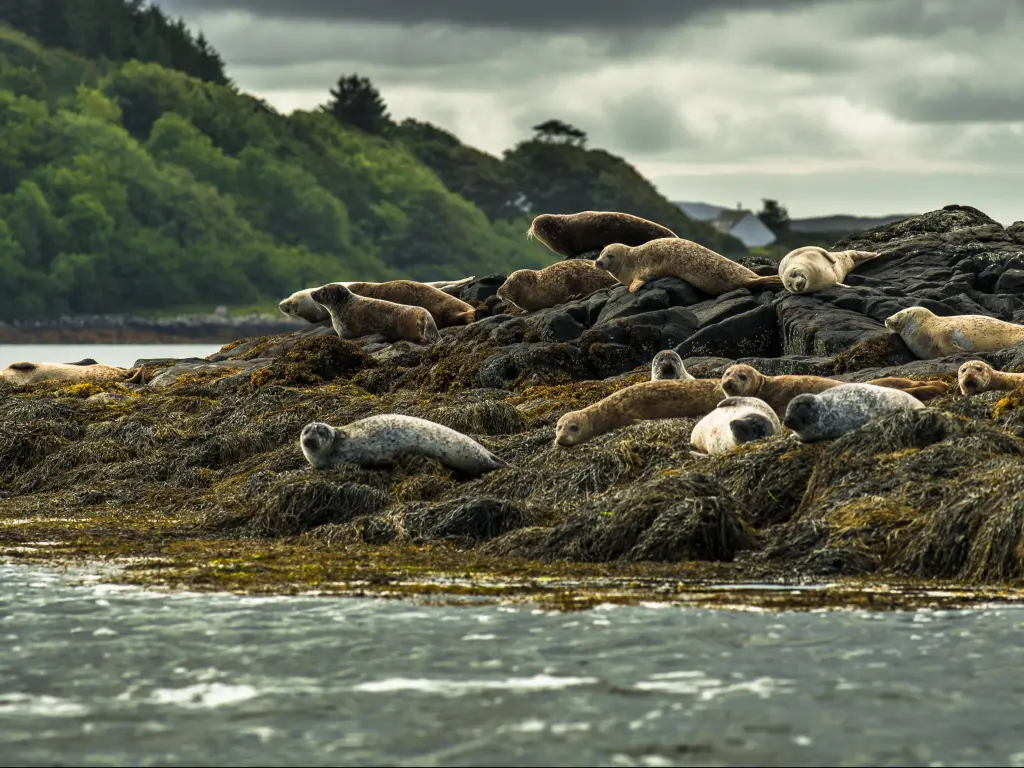
The Skye Live Festival takes place in May and is a celebration of traditional Scottish music in one of the most incredible settings, with views of the Cuillin Ridge and the Old Man of Storr.
When visiting the home of Malt Whisky, it would be rude not to indulge in a dram or two. Talisker is one of the most popular malts and its home lies in Carbost on the shores of Loch Harport on the west coast of Skye. Visiting in September will allow you to enjoy the Hebridean Whisky Festival which takes place at the start of the month, and lasts just over a week.
The Isle of Skye Highland Games take place in August and have taken place since 1877, with traditional music, dancing, and heavy events such as tossing the caber, the games are a unique illustration and celebration of the highland way of life.
Things to see once you reach the Isle of Skye
The drive to the Isle of Skye takes you through some of the most amazing scenery in the UK, through beautiful deer-filled glens, passing mountains, castles and charming highland villages along the way. Once you reach the Island, here are our top tips of things to see
- Portree -The capital of the island and the cultural centre, with many attractions and a perfect base from which to explore the island. Sample some of the finest seafood down by the harbour.
- Dunvegan - Home to the Clan Macleod for over 800 years, and the historic Dunvegan Castle and Gardens. The oldest inhabited castle in Scotland, set in amongst amazing 42,000-acre grounds.
- Elgol - Set on the shores of Loch Scavaig, this beautiful little hamlet on the south coast is worth the journey alone, through the Red Cuillin with incredible views.
- Talisker - Visit the oldest working distillery on the island, surrounded by the Cuillins set on the banks of Loch Harport. Giving a unique taste of Skye, in the most fantastic setting.
- The Old Man of Storr - Located in the north of Skye, on the Trotternish Peninsula, the Old Man is one of the most photographed rocks on the island. This unique rock pinnacle stands 50 metres high and according to legend was originally a local giant who is buried here.
- Fairy Pools - The Island is famed for being magical and its enchanted history will lead you to believe fairies inhabited the island many moons ago. The Fairy Pools are one of the best places for wild swimming with crystal clear waters amidst the stunning backdrop, tempting even the most nervous in for a dip.
- Applecross - Whilst not on Skye itself, the turn-off to Applecross is only 6 miles from the Bridge. This incredible detour takes you up the Bealach Na Ba, with the steepest ascent of any road in the UK, to its peak at over 2,000 feet. It's not for the faint-hearted, but the viewpoint at its peak gives an amazing view over to Skye and the Cuillins, before descending to the renowned Applecross Inn for some of the finest seafood you will find.
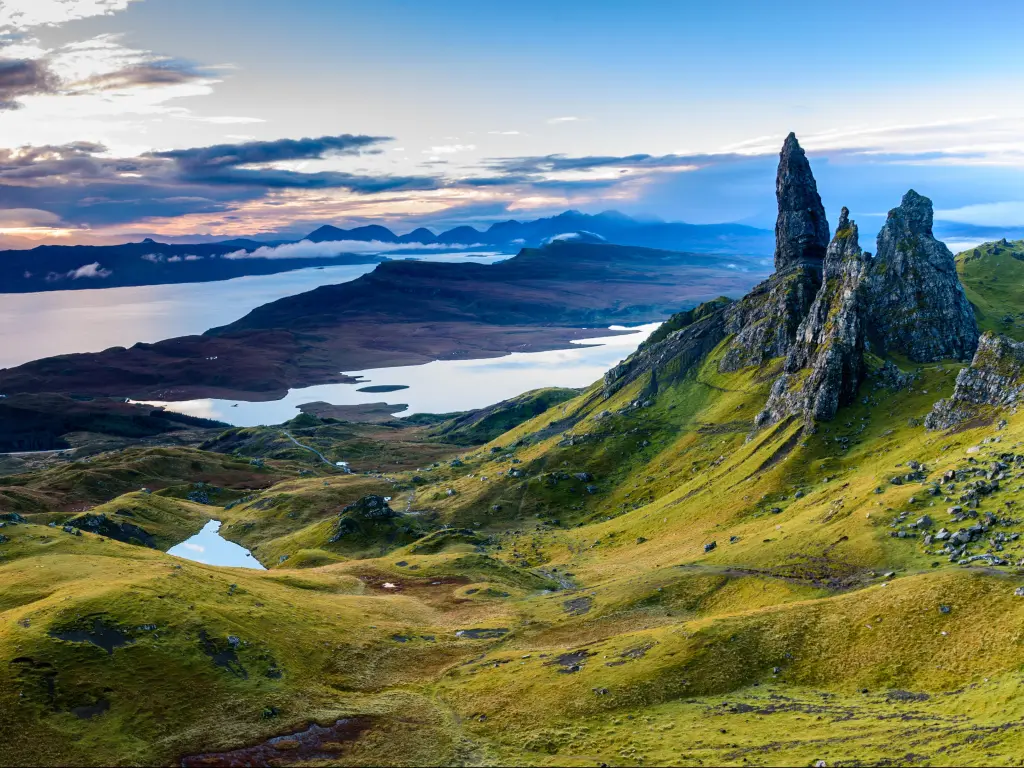
The Isle of Skye is one of the most visited places in Scotland, and for good reason, with its towering peaks, amazing scenery, wildlife and excellent walking trails, it is an outdoor adventure paradise.


